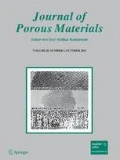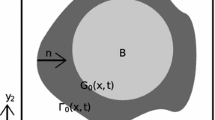Abstract
A finite-element-based method is presented for evaluating the effective gas diffusion coefficient of porous solids. Using this method, the 3-D micro-scale geometries of the porous solids are constructed under the ANSYS platform by the parametric code; the relation between effective gas diffusivity and micro-scale features of random-distributed porous solids is established. The results show that in random-distributed pore media, there is a percolation threshold ε p, and this percolation threshold decreases with increasing coordination number of the pore network. The relationship between the effective diffusivity and porosity is strongly nonlinear when the porosity, ε, is less than a certain value ε L ; for ε > ε L , the relationship becomes quasi-linear. This dividing point ε L decreases with increasing coordination number. The larger the coordination number of the pore network, the higher the effective gas diffusivity. Based on the simulation results and observations, a formula relating the effective diffusion coefficient with porosity is proposed.
Similar content being viewed by others
References
S.P.S. Andrew, Chem. Eng. Sci. 36, 1431 (1981)
N. Wakao, J.M. Smith, Chem. Eng. Sci. 17, 825 (1962)
S. Litster, G. McLean, J. Power Sources 130, 61 (2004)
B.A. Westrin, A. Axelsson, Biotechnol. Bioeng. 38, 439 (1991)
G.H. Neale, W.K. Nader, AIChE J. 19, 112 (1973)
M.M. Mezedur, M. Kaviany, W. Moore, AIChE J. 48, 15 (2002)
R. Mann, J.J. Almeida, M.N. Mugerwa, Chem. Eng. Sci. 41, 2663 (1986)
M.H. Abbasi, J.W. Evans, I.S. Abramson, AIChE J. 29, 617 (1983)
R.M. Riley, F.J. Muzzio, H. Buettner, S.C. Reyes, AIChE J. 41, 691 (1995)
M. Sahimi, D. Stauffer, Chem. Eng. Sci. 9, 2225 (1991)
M. Sahimi, J. Chem. Phys. 96, 4718 (1992)
S. Trinh, P Arce, B.R. Locke, Transport Porous Med. 38, 241 (2000)
J.A. Currie, Brit. J. Appl. Phys. 11, 314 (1960)
J. Hoogschagen, Ind. Eng. Chem. 47, 906 (1955)
J.H. Kim, J.A. Ochoa, S. Whitaker, Transport Porous Med. 2, 327 (1987)
J.C. Maxwell, A Treatise on Electricity and Magnetism, 2nd edn. (Claredon Press, Oxford, 1881)
D.A.G. Bruggeman, Ann. Phys. 24, 636 (1935)
H.L. Weissberg, J. Appl. Phys. 34, 297 (1963)
Acknowledgment
The authors of this paper are very grateful for the comments made by the reviewers.
Author information
Authors and Affiliations
Corresponding author
Rights and permissions
About this article
Cite this article
Mu, D., Liu, ZS., Huang, C. et al. Prediction of the effective diffusion coefficient in random porous media using the finite element method. J Porous Mater 14, 49–54 (2007). https://doi.org/10.1007/s10934-006-9007-0
Received:
Revised:
Published:
Issue Date:
DOI: https://doi.org/10.1007/s10934-006-9007-0




